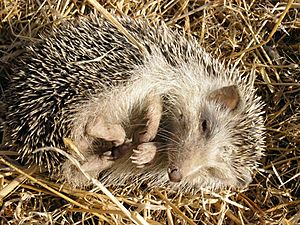North African hedgehog facts for kids
Quick facts for kids North African hedgehog |
|
|---|---|
 |
|
| A North African hedgehog in the Balearic Islands | |
| Conservation status | |
| Scientific classification | |
| Genus: |
Atelerix
|
| Species: |
algirus
|
 |
|
| North African hedgehog range | |
The North African hedgehog (also known as the Algerian hedgehog) is a small, spiny mammal. Its scientific name is Atelerix algirus. You can find these hedgehogs in countries like Algeria, Libya, Malta, Morocco, Spain, and Tunisia.
Not a lot is known about these hedgehogs in the wild. However, they are important because they helped create the most common type of domesticated hedgehog. This happened by crossing them with four-toed hedgehogs. The North African hedgehog is the only one of the four African hedgehog species that lives outside of Africa. Scientists think humans might have brought them to places like Spain and the Canary Islands. These hedgehogs are not currently at risk because they live in many different places and their numbers seem stable.
Contents
About the North African Hedgehog
The North African hedgehog looks a lot like the European hedgehog. However, there are some clear differences between them.
Size and Appearance
North African hedgehogs are usually smaller than European hedgehogs. They grow to be about 20 to 25 centimeters (8 to 10 inches) long. They can weigh up to 650 grams (about 1.4 pounds). Even though they are smaller than European hedgehogs, they are larger than other African hedgehog species. They also have a longer snout and longer legs. This helps them run faster.
Their face is often light, usually white. Their legs and head are brown. The fur on their belly can be brown or white. They have large, easy-to-see ears. Their body is covered in soft spines. These spines are mostly white with darker bands. A key way to tell them apart is that they do not have spines on the top of their head. This means they do not have a "widow's peak" like some other hedgehogs.
Common Parasites
These hedgehogs can sometimes have a specific type of flea. This flea is called the hedgehog flea, or Archaeopsylla erinacei maura.
Where North African Hedgehogs Live
Scientists do not know a lot about where North African hedgehogs prefer to live. They have been found in areas with Mediterranean forests. These forests have both conifer and mixed trees. You can find them in the southern mountains of Spain and northern Africa.
Geographic Range
In northern Africa, they live from Morocco all the way to Libya. However, they cannot survive in very dry desert areas. They also live in other warm places. These include the Canary Islands and the Balearics. Within these regions, you might spot them in gardens and parks. Sadly, they no longer live in France.
North African Hedgehog Life Cycle
Understanding how North African hedgehogs live and reproduce is very interesting.
Reproduction and Young
The time a mother hedgehog carries her babies is called the gestation period. For North African hedgehogs, this lasts from 30 to 40 days. A mother usually gives birth to three to 10 babies, called hoglets. They often have two litters of babies between October and March.
When hoglets are born, their skin is pink and hairless. They also have small, soft spines. These soft spines fall off later. Around four weeks old, the hoglets get their harder, stiffer quills. Hoglets usually weigh between 12 and 20 grams (less than an ounce) at birth.
Maturity and Mating
North African hedgehogs become old enough to have their own babies when they are about eight to ten weeks old. These hedgehogs do not mate for life. This means they do not form a lasting pair bond with one partner.
Internal Parasites
The North African hedgehog can be a host for an intestinal parasite. This parasite is called Moniliformis aegyptiacus. It belongs to a group of worms called Acanthocephala.
See also
 In Spanish: Erizo moruno para niños
In Spanish: Erizo moruno para niños


